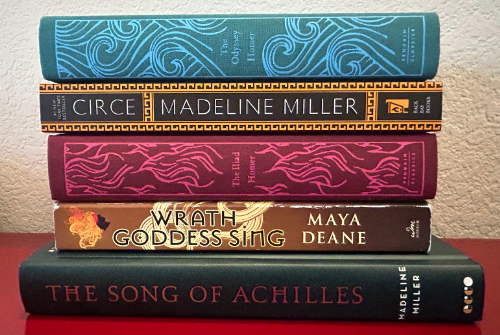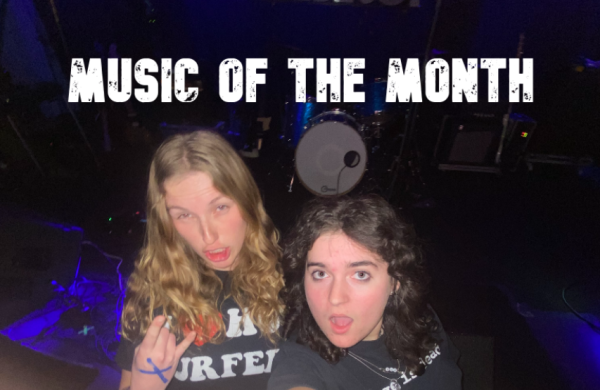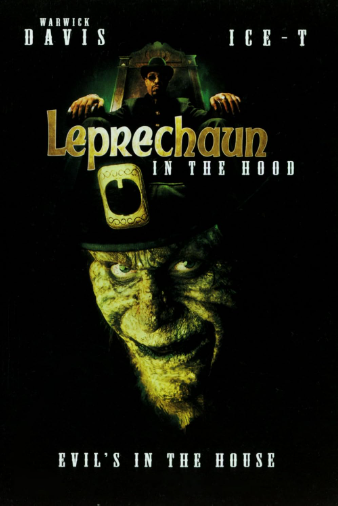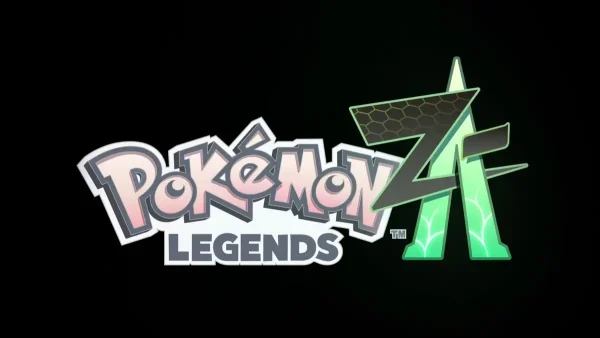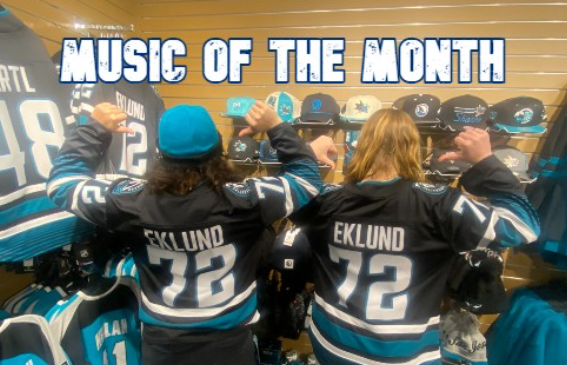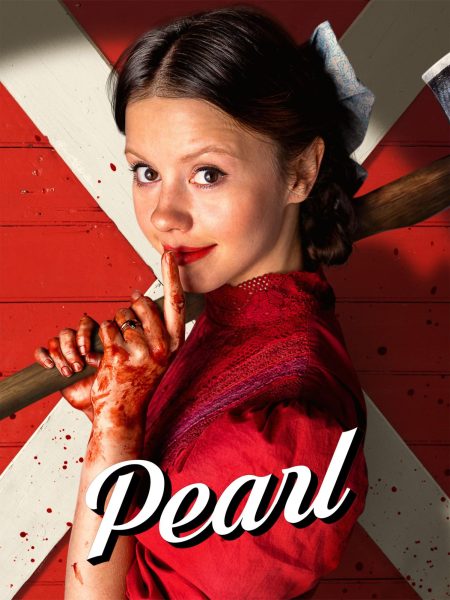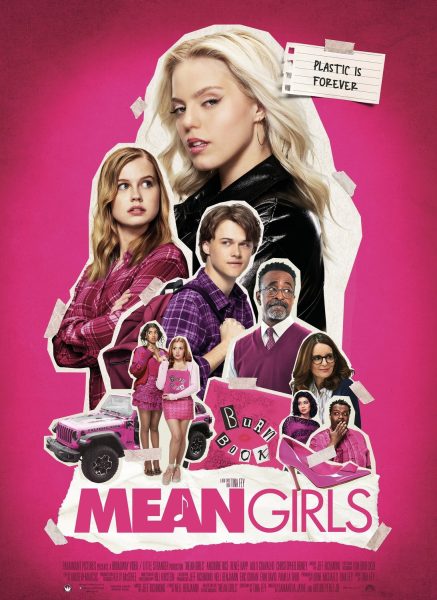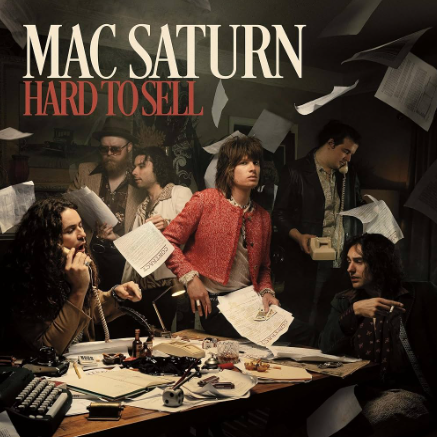Music of the Month: May
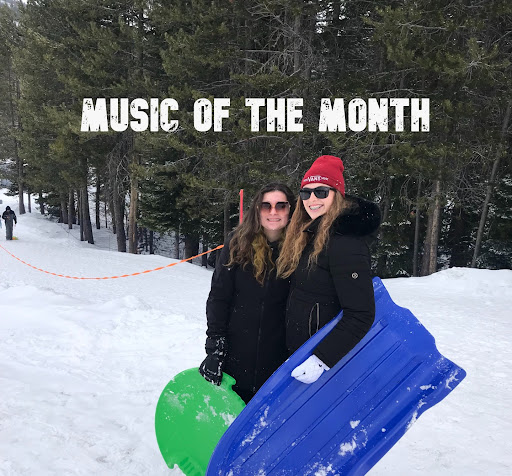
Brianna and Cali compile a list of their ten favorite songs and some honorable mentions each month and go in depth with them.
June 1, 2022
Happy May! Unfortunately, this is our last edition of Music of the Month for the 2021-22 school year. We’ve truly had a blast taking time each month to write about some of our favorite songs, bands, and albums, and we hope you’ve enjoyed it too. Hopefully, we can continue Music of the Month next school year, so stay tuned (no pun intended) for that. As always, we’ve each picked our five favorites and three honorable mentions and gone in-depth with them.
Cali’s Picks:
“One Headlight” by The Wallflowers, “Bringing Down the Horse” (1996)

The opening track on The Wallflowers’ most commercially successful album, “One Headlight” quickly brings the listener into a nostalgic realm through the satisfying slide guitar of the intro and the dreamy vibe heard throughout the song. Lead vocalist and guitarist, Jakob Dylan, exhibits the extraordinary songwriting he inherited from his father (Bob Dylan), by telling a melancholy story about overshadowing consumerism and the loss of, “his only friend”. Dylan divides this sorrowful mood through the anthemic choruses that state we can make it in this broken and greedy world by driving “home with one headlight”. The five-minute-long track creates one of the most memorable alternative ballads of the 90s through the pulsing drumming, soothing vocals delivered by Dylan, the nonchalant soloing, and unique aspects like a background organ and bluegrass-like guitar that bridges the verses and choruses together. The multiple upbeat solos highlight The Wallflowers’ influences and show their attempts to bring bluesier and folk-centered sounds into mainstream rock and alternative. This breathtaking tune spent five weeks at the number two spot on the Billboard Hot 100 chart, and a whopping 70 weeks in total on the charts. It also broke records in 1997 by becoming the first song to top all three of Billboard’s rock charts: Modern Rock Tracks, Mainstream Rock Songs, and Adult Alternative Songs. By touching on the subjects of loss, friendship, getting through tough times together, feeling displaced, and acknowledging the positives and negatives of our world, “One Headlight” stirs up emotions within anybody listening, and brings a hearty and swoon-worthy story that can easily make it the modern-day “American Pie”.
“Street Spirit (Fade Out)” by The Darkness, “Hot Cakes” (2012)

After performing the classic Radiohead song live several times, The Darkness decided to record a studio version that served as the penultimate track on their third studio album, “Hot Cakes”, which came seven years after the release of their second album. The Darkness’ cover highly contrasts to the original version’s acoustic guitars, ballad-like structure, and ethereal vocals, as it is replaced with Justin Hawkins’ wails that display his golden pipes, the screaming guitars, and hard-hitting and driving drums. The British rock outfit showcases their 80s metal-like style and successfully creates a rock epic through their fierce glissandos and rabid solos courtesy of Dan Hawkins (Justin Hawkins’ younger brother). The striking number hits the listener with the force of a freight train with its pumping riffs and pounding drums. Dan Hawkins further tributes Radiohead by sneaking in a riff from their hit, “Just” after the first chorus. The propelling energy of the number allows for the construction of a fan favorite, and a mind-blowing cover that some would consider to be better than the original.
“Still In Hollywood” by Concrete Blonde, “Concrete Blonde” (1986)

During the conclusion of most post-punk movements and the emergence of hair metal, synthesizers, and signature “80s” music, Concrete Blonde made its way out of LA’s blossoming music scene after getting a long-awaited record deal and drummer. The group mixed many genres and even served as a pioneering goth rock band. The release of their first, self-titled album left a withstanding impact that allowed it to enter the Billboard Top 100 and the generating of three singles. One of these singles is the catchy, yet complex, “Still In Hollywood”. The track begins with brisk studio chatter, a count-in with drumsticks, and a snappy, punk-sounding guitar riff. The lyrics talk about the vastness and many sides of Hollywood, including the glitz and glamor(“the queen of L.A.”, “silver tears of rain hung from the leaves”), as well as the destitute sectors (“troll on the corner”, “he’s living under a truck”). Bassist and singer Johnette Napolitano evinces her diverse and wide vocal range throughout the track and sings in her rough voice in a more staccato manner; which greatly differs to her signature smooth and legato singing. Former Sparks guitarist James Mankey shines throughout the song with his tough and groovy riffs, thematic and near-perfect solo that occurs after the second chorus, and his background whammy trills. The outro of the song provides a model falling action with the repetition of the chorus with Mankey’s advanced soloing replacing the riff, and the gradual deceleration of the ensemble as it’s taken over by uproarious feedback. “Still In Hollywood” should be regarded as an essential track to all Concrete Blonde fans, as well as those familiar with the genres of post-punk and 80s alternative.
“Yer Blues” by The Beatles, “The Beatles (White Album)” (1968)

While The Beatles visited India in 1968, John Lennon began to experience feelings of alienation and uneasiness from his fellow bandmates. Owing to these emotions, Lennon decided to write a blues song that would channel these emotions as well as pay homage to his blues heroes (but also criticize the current British blues scene). The result of this was “Yer Blues”, a jangly track featured on the second LP of the Beatles’ iconic White Album. The number begins with Lennon slowly counting, “two, three,” before the dismantling Beatles break into a rhythmic ensemble with a gritty riff that digs deep into the listener’s ears. Lennon’s vocal approach is raw and imperfect, shedding light on his ability to primally scream and croon, as heard on later tracks recorded by the Fab Four. In the choruses, Lennon is accompanied by a barely audible Paul McCartney, further contributing to the mysterious and haunting tones of the song. Following the last chorus, Lennon breaks into a raucous and distorted guitar solo, a rarity considering the time. Lennon’s guitar is taken over by George Harrison’s as he continues to drill the heaviness of the ditty. The solos transition into an outro riddled with Lennon’s quiet repetition of, “Yes I’m lonely/ Wanna die,” and the return of the crunching verse riff. This track, which was later covered by The Dirty Mac, a supergroup consisting of British rockers like Lennon, Eric Clapton, Keith Richards, and Mitch Mitchell at the Rolling Stones’ Rock and Roll Circus, showcases the versatility and diversity of the Beatles, even in the beginning phases of their disintegration. The hard-hitting hookiness of this song truly shows that the Beatles could hang with blues stars, as well as successfully experiment with a multitude of genres.
“Rise Above This” by Seether, “Finding Beauty in Negative Spaces” (2007)

A heart-wrenching, yet inspiring tune that kicks off with an uptempo drum beat before Shaun Morgan’s distorted guitar overtakes the rhythm section. The verses are filled with Morgan’s melodic voice, subtle high-pitched soloing guitars, as well as a quieter acoustic guitar. The choruses are strident and transition smoothly from the last bounding line of each verse, fulfilling the listeners with the diluted heaviness of the guitars and drums, as well as Morgan’s constructed screams. The bridge repeats the line, “I’ll mend myself before it gets me”, and is extremely dynamic as it begins in a hushed fashion until it hits an overdriven peak that quickly fades into the last chorus and clean outro. This song touches on larger subjects, like how much the absence of a loved one can affect somebody: “…listen closely, I’m lost without you” and, “Call your name every day/When I feel so helpless”. However, this track also talks about resilience and pushing through the deficits and hardships in life: “I’ve fallen down, but I’ll rise above this”. This number also incorporates and shows Seether’s influences, like Nirvana, through the quiet verse, loud chorus structure. Following the release of “Finding Beauty in Negative Spaces” and eventually the “Rise Above This” single, the moving track quickly became a fan favorite and essential track in Seether’s catalog.
Honorable Mentions
“Andres” by L7, “Hungry For Stink”(1994)

The opening track on L7’s fourth studio album, “Hungry For Stink”, that simply drips with angst and guttural energy through the heavy riffs, rough vocals, and disgruntled and impromptu guitar solos. “Andres” was released as a single in support of the album, and peaked at #34 on the British charts in July 1994, showing even after the death of Kurt Cobain and the widespread fall of grunge, that the public still craved any form of this grimy and powerful alternative rock.
“Forest” by System Of A Down, “Toxicity”(2001)

A riveting track off System Of A Down’s seminal album, “Toxicity”, that addresses issues like the environmental crisis and how mankind turned on nature; through lyrics that contain a hypothetical conversation between a man and Mother Nature. Drummer John Dolmayan shines throughout the number, but especially in the intro as he annihilates his drum kit to play in perfect coincidence with Daron Malakian’s guitar. Serj Tankian, the lead vocalist of System Of A Down, exhibits his vocal prowess and further emphasizes his lyrics through the somewhat over-exuberation of certain lines.
“Minerva” by Deftones, “Deftones” (2003)

Beginning with faint and euphonic guitar chords that are taken over by a contrasting loud and distorted guitar, “Minerva” is a very enthralling track that consumes the listener’s attention with the driving guitars, pounding drums, and mind-warping vocals. This song is a euphoric and somewhat psychedelic trip with an intriguing aura that evokes feelings of satisfaction and fulfillment, even though very little is known about the meaning of the song itself. Throughout Deftones’ fourth studio album, they adopt and mix many genres and styles; some new and others heard in other works, proving that they truly are the “Radiohead of metal”.
Brianna’s Picks:
“Stacked Actors” by Foo Fighters, “There Is Nothing Left to Lose” (1999)

The opening track on Foo’s third studio album, “Stacked Actors” begins with a hard rock intro that is followed by a jazzy counterpart. Dave Grohl exhibits a moody and temperamental atmosphere that is apparent in the vocals and instrumentation. “There Is Nothing Left to Lose” includes more of a collection of mellow songs compared to other albums— which is interesting that the opening track is one of the grungiest songs of the Foo Fighters’ discography. “Stacked Actors” begins with heavy chords from Grohl and complex drum fills courtesy of the late Taylor Hawkins. Hawkins’ effortless switch between the light swing drumming to hard crashing grooves is unparalleled much like his other drum performances. This track is just a small representation of his drumming capabilities. Foo members (at the time of composing the album, only consisted of Grohl, Hawkins, and bassist Nate Mendel) take a stab at society’s renowned individuals, specifically those of the acting profession. Recorded in the basement of his home in Virginia, Grohl, Hawkins, and Mendel also include percussion that only appears behind the verses of the track. The specific percussion instrument is unspecified but could be a guiro or a cabasa— both are Latin-based instruments. Between the raucous guitar sound and lazy vocal delivery, Foo Fighters deliver an exceptional, direct, and honest introduction to their canorous third studio album.
“Show Me Your Soul” by Red Hot Chili Peppers, “Pretty Woman” (1990)

With fun percussion sounds, “Show Me Your Soul” is launched with short bursts of the full ensemble that makes up the RHCP sound. The mix of the rap and melodic chorus is also a staple of the band’s distinctive discography. This track is the final song that appears on the “Pretty Woman” soundtrack and was recorded during the “Mother’s Milk” tour with the new addition to the group, guitarist John Frusciante (who later departs and rejoins the band a total of two times). Although this song has amazing vocals and composition, “Show Me Your Soul” has never been performed in front of a live audience. The funk-rock number includes two brilliant well-composed instrumental breaks and solos. The first is a keyboard-driven interlude that features musician Billy Preston. Preston’s work largely consisted of R&B, gospel, funk, soul, and rock. During his time as a renowned musician, Preston was associated with many acts such as The Beatles, the Rolling Stones, Ray Charles, Eric Clapton, and Sam Cooke. The following instrument break shows off the guitar and the early genius of Frusciante. The second sole instrumentation is then interrupted by interesting vocalizations but the exceptional guitar is sustained and carried into the instrumental outro. Throughout the entire track, Flea’s iconic bass lines are even more prevalent but are still unmatched like all of his other works. “Show Me Your Soul” never appears on a studio album but was added to a compilation album of RHCP’s earlier works “What Hits!?” (1992).
“So Real” by Jeff Buckley, “Grace” (1994)

A brilliantly written song on an exceptional album, “So Real” begins with a mellow guitar that breaks into a bittersweet, melancholy tone. From beginning to end, the track switches at one point and turns the latter half of the song into a completely different genre; the waltz-y rhythm, evident in the first part of the song, flips into a distorted and heavy number. Succeeding the hard rock number, just when you think the song comes to its end, the track subsides into a brief acapella break where Buckley says “I love you” followed by a tone similar to the beginning instrumentation and carries through the rest of the bridge. Based on the solitary lyric, it may symbolize the simplicity of saying these words to a significant person in one’s life but it is also isolated to show its importance. He then follows by stating “But I’m afraid to love you” which is slightly covered by the flowing instrumentation that is similar to the very beginning. Many believe that Buckley uses wordplay in the repetitive chorus “That was so real” to make it interchangeable and sound like “That was surreal”. Something can be so intense or real, that it’s surreal which is why a lot of fans have recognized this theory. Tragic irony is also apparent in this track, communicated through the lyric, “And I couldn’t awake from the nightmare, that sucked me in and pulled me under/Pulled me under”. Buckley had the ability to paint an entire picture in one’s mind with very minimal words. Three years after the release of his first studio album, Buckley passed away in a drowning accident when he was waiting for the arrival of the rest of his band in Memphis, Tennessee. No matter the intent behind the lyric’s meaning, this song is all the more significant because of its devastating foreshadowing. Buckley’s voice was indisputably breathtaking between his whispery voice of the first verse and falsetto background vocals that are so powerful and elevates the entire performance. So many words can be used to describe this song but concomitantly, not enough can depict the intensity and power which it holds.
“Mrs. Butterworth” by Nirvana, “With The Lights Out” (2004)

A demo recorded in Kurt Cobain’s home in Aberdeen Washington during the summer of 1988 with then drummer Aaron Burckhard, the true title of this track is unknown but many fans believe their record label at the time named it. Much like the title is unknown, many things about the track in general. Although the abandoned song never made it to an official studio album, fans have suspicions that “Mrs. Butterworth” eventually evolved into “Swap Meet” which appears on Nirvana’s debut studio album “Bleach” (1989). The lofi heavy riff is similar to a lot of songs but stands out in its own way. The possibly improvised track also includes a rant or speech in which Cobain describes himself or an individual opening a flea market and accumulating a lot of money from selling his DIY projects.
“Even The Losers” by Tom Petty and The Heartbreakers, “Damn The Torpedoes” (1979)

Fading into an intricate temporary drum solo followed by a brief acoustic riff, “Even The Losers” possesses simple but moving lyrics. What makes this track stand out is the short voice recording of guitarist Mike Campbell’s wife, Marcie, yelling, “It’s just the normal voices in here”. Petty’s discography consists of accessible tunes for all. His distinctive drawl contrasting against the sharp guitar playing is evident in his body of works but is specifically notable in this track.
Honorable Mentions:
“You Oughta Know” by Alanis Morissette, “Jagged Little Pill” (1995)

Raw and unconventional, “You Oughta Know” is one of Morissette’s top hits; with good reason. It’s fully upfront and candid with the emotional vocals of Morissette. This track includes the studio performance from Flea and Dave Navarro, respectively from Red Hot Chili Peppers and Jane’s Addiction.
“Screenwriter’s Blues” by Soul Coughing, “Ruby Vroom” (1994)

Spoken word and stream of consciousness, “Screenwriter’s Blues” is considered to be the most psychedelic track on the already psychedelic album. There is no direct message in the song but many debate that the track is left up to the interpretation of the listen, which may be the message itself.
“Psychotic Break” by Jerry Cantrell, “Degradation Trip” (2002)

The leading track on Cantrell’s second studio album, “Psychotic Break” has hauntingly amazing lyrics, extraordinary vocals, heavy but smooth guitar riffs, and complex drumming.




